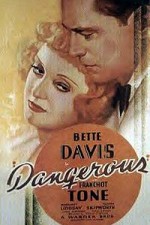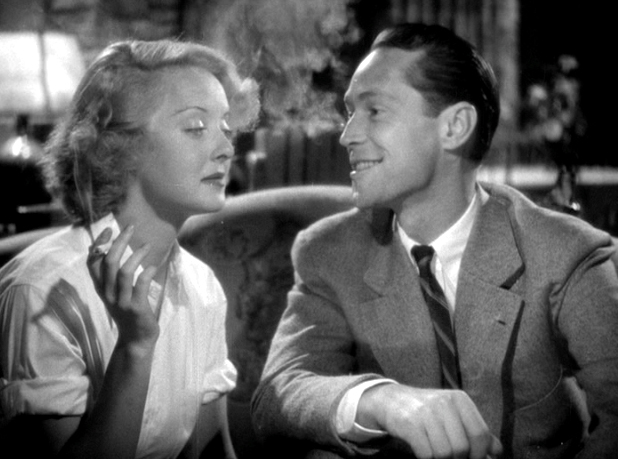 Seasons of Bette. Episode 2. Nomination #1
Seasons of Bette. Episode 2. Nomination #1
As a sidebar to Anne Marie's "A Year With Kate" series (which I hope you're all enjoying as much as I am - see why I comissioned it?), I'm investigating each of Bette Davis's Oscar nominated performances as they appear within the Katharine Hepburn timeline. They're the two titan actresses of Old Hollywood so why not pair them even if indirectly? We previously looked at Of Human Bondage (1934) due to its write-in votes at the Oscars but technically-speaking Nomination #1 arrived the following year in Dangerous (1935).
This second Oscar hopeful is so like the first it's as if someone yelled "Do over! And get the nomination this time."
Again Bette Davis is pursued by a lanky gentleman and failed artist -- 1934's sap was Gone With the Wind's Leslie Howard and 1935 brings us Mutiny on the Bounty's Franchot Tone. They both do it for me a lot more than they seem to do it for Bette but Tone, and her sexual chemistry with him, is 1935's only added value.

Again Bette Davis is unflatteringly described as soon as her very first scene -- 1934's version was "ill natured and contemptible" and in 1935's we get "vitally tempestuous creature" which isn't so bad but then the men gathered in conversation quickly add "down and out and dowdy" and "jinxed". Again the otherwise smart young man becomes enormously stupid in her presence, inviting her into his home with no cross or garlic to protect him. Again the decent fellow breaks it off with his fabulously sane and successful brunette girlfriend in favor of this unemployed drunk harpy who is, as literally every character warns him including the woman herself, no damn good.
Again this tempestuous creature expresses disinterest or contempt at each turn except when she realizes there's something in it for her -- money, a place to crash, a second chance, a roll in the hay (both euphemistically and literally in Dangerous). But I think what Bette as "Mildred" (34) and "Joyce Heath" (35) loves most about "Philip" (34) and "Don" (35) is the target practice.
She comes in like a wrecking ball.
Though we're spared the distracting cockney accent this time, the chief difference in her performance this time is the energy. Dangerous is a downgrade. The weirdest and perhaps most awesome moment in terms of a perfectly precise illustration of What's Wrong Here is an early scene when Bette flies into a serious rage and screams humiliating things at her new man when he tells her she's a drunk.

The only feeling you can arouse in a man is pity.

Pity. Pity?!? You dare feel sorry for me?! You with your fat little soul and your smug face. Picking your way so cautiously through a pastel existence. Why I've lived more in a day than you'll ever dare live. Pity for me?!? That's very funny because I've never had any for men like you."
At the end of her loudest, longest, and most repulsive tirade in 1934 she stormed out slamming a door and then seriously fucked up his shit in the kind of permanent ways Angela Bassett copied in modern times in Waiting to Exhale. (In that modern female-empowerment version, still very post-code mind you, the man deserved it. The only thing Bette's men in 1934 and 1935 deserve is a little respect pity.) At the end of this relatively quiet, reasonably short, vaguely unpleasandt tirade in 1935 she just abruptly stops screaming and tilts forward, eyes closing, spent, like all the air went out of her rage. She stumbles to a nearby chair, the fury dissipated and immediately replaced with half-hearted bitchiness.

Even her co-star seems visibly thrown by this in a "that's all the fight you have in you?" kind of way. But then Franchot Tone was married to Joan Crawford at the time so perhaps this was akin to a warm snuggle.
All the air goes out of the movie, too, in its terrible last act which carries the whiff of lost nerve or, more likely, post code demands about what lessons we might glean from all of this. Rather than killing her off as in Bondage, they (gulp) reform her.
They tried to make Bette go to rehab? Just say no no no.
[SPOILERS] So let's pretend the last act didn't happen. How evil is Bette in the juicier moments in Dangerous? So evil that she's willing to kill her husband that's she's been keeping a secret and two-timing. So evil that she lets her new man throw away his fortune for her career even when she knows she's unreliable. So evil that she breaks expensive things, drinks all the liquor and treats the help like shit even though she's a free-loading guest at the country estate. [/SPOILERS] So evil that when she smiles at Franchot in a barn, after suggestively napping in the hay, it's less warmly seductive than unnaturally fake like Wednesday Addams after a stint in the Harmony Hut. Or maybe like a cat that's spotted a terrified mouse. All of Bette's best moments are watchful and predatory, like a terrifically played post-rainstorm flirtatious sequence when she reads a make-believe play to test the romantic interests of her new benefactor. But the movie lacks her nerve and her character arc makes little sense in the long run.
In the Best Actress battle of 1935, Katharine Hepburn's Alice Adams was a worthier victor (by far) but Bette was the new intoxicatingly dangerous and nervy star, even if her movie was anything but.

Next Up: Jezebel (1938) on March 30th. Watch it before then if you've never seen it. Or watch it again because it's quite good.